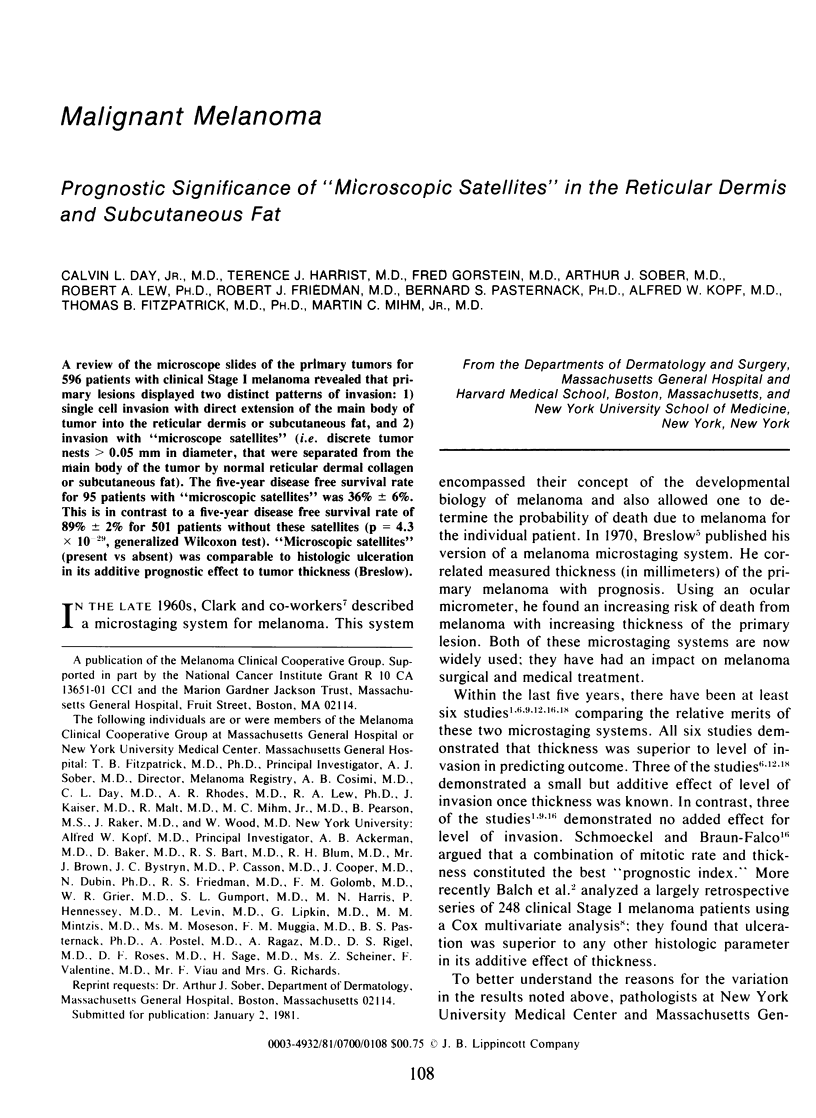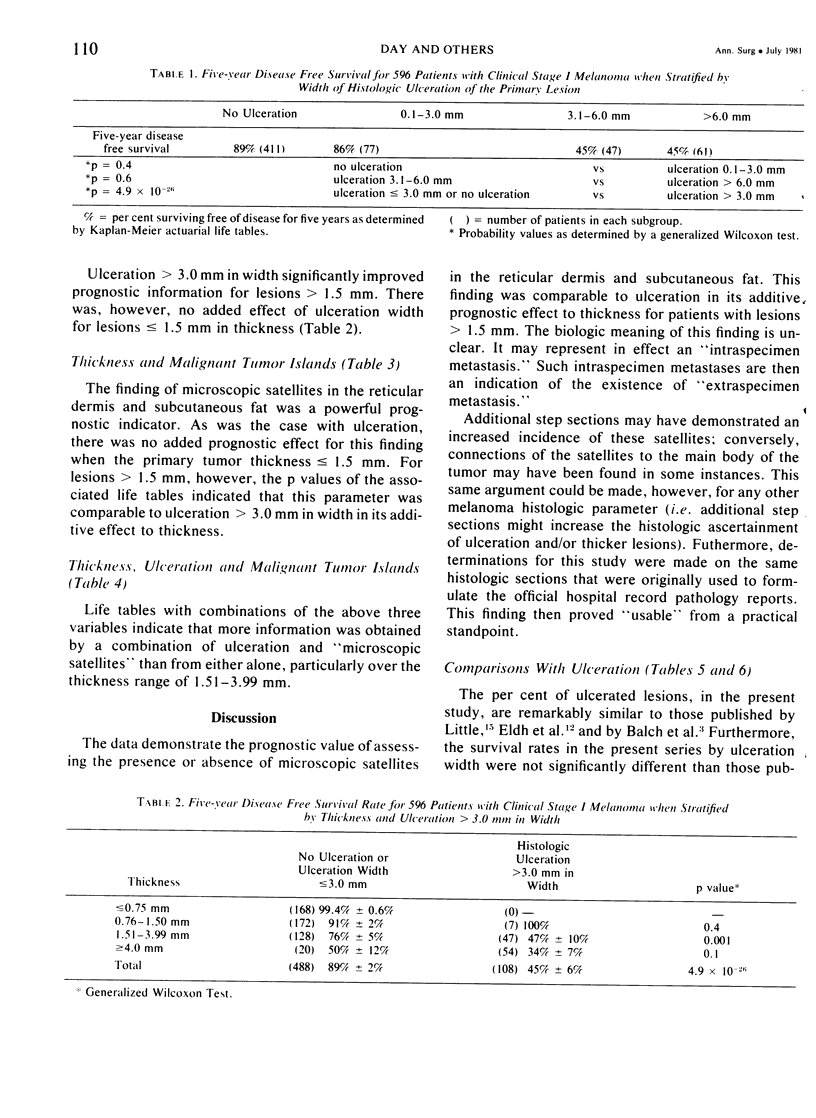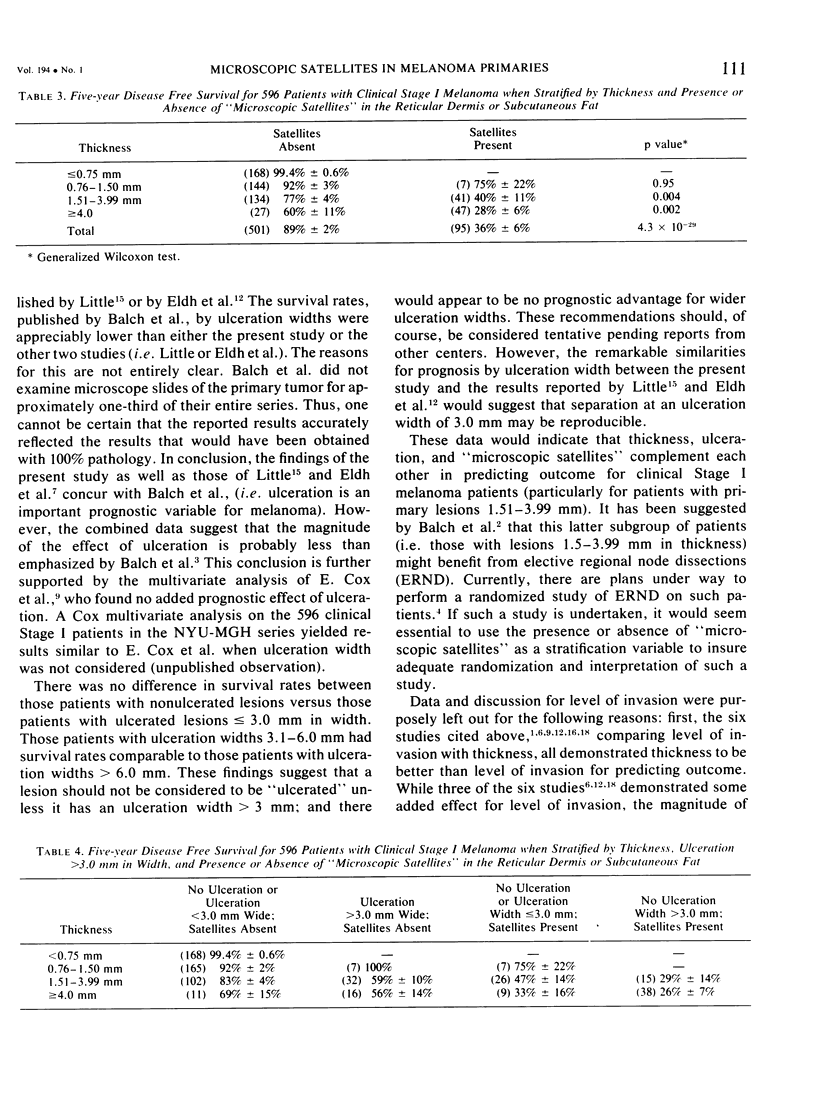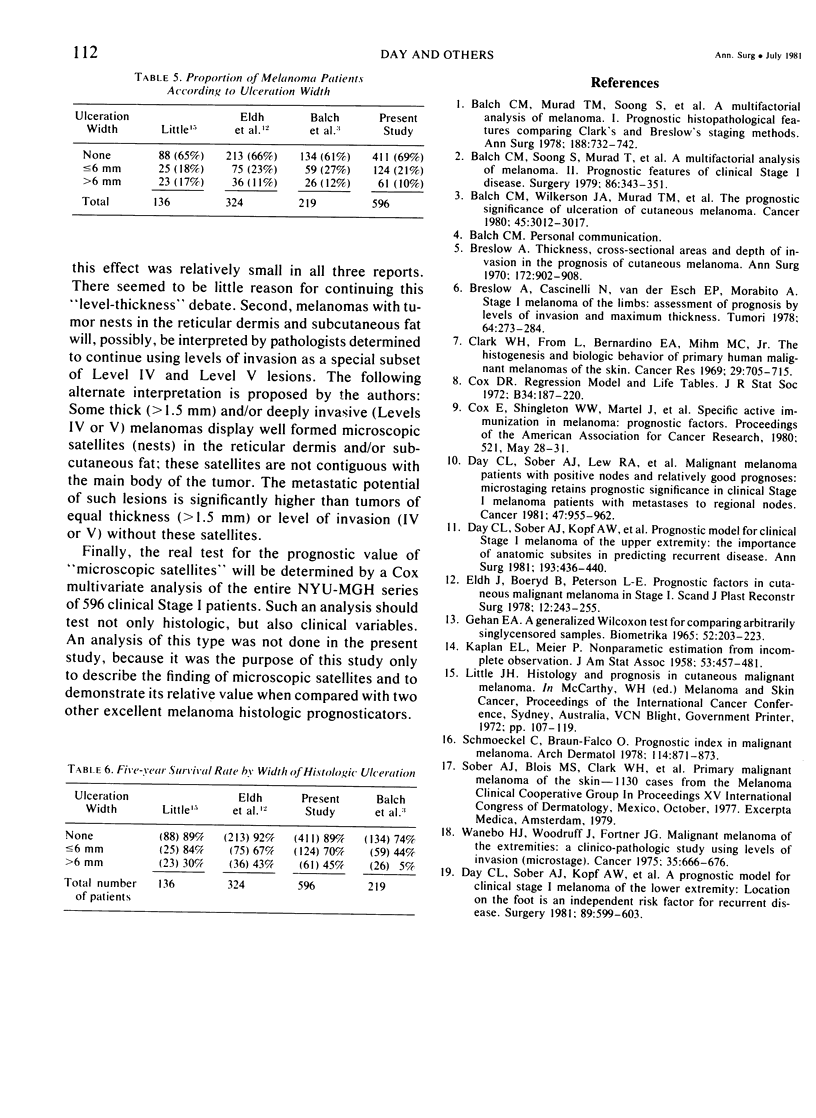Abstract
A review of the microscope slides of the primary tumors for 596 patients with clinical Stage I melanoma revealed that primary lesions displayed two distinct patterns of invasion: 1) single cell invasion with direct extension of the main body of tumor into the reticular dermis or subcutaneous fat, and 2) invasion with "microscope satellites" (i.e. discrete tumor nests greater than 0.05 mm in diameter, that were separated from the main body of the tumor by normal reticular dermal collagen or subcutaneous fat). The five-year disease free survival rate for 95 patients with "microscopic satellites" was 36% +/- 6%. This is in contrast to a five-year disease free survival rate of 89% +/- 2% for 501 patients without these satellites (p = 4.3 x 10(-29), generalized Wilcoxon test). "Microscopic satellites" (present vs absent) was comparable to histologic ulceration in its additive prognostic effect of tumor thickness (Breslow).
Full text
PDF




Selected References
These references are in PubMed. This may not be the complete list of references from this article.
- Balch C. M., Murad T. M., Soong S. J., Ingalls A. L., Halpern N. B., Maddox W. A. A multifactorial analysis of melanoma: prognostic histopathological features comparing Clark's and Breslow's staging methods. Ann Surg. 1978 Dec;188(6):732–742. doi: 10.1097/00000658-197812000-00004. [DOI] [PMC free article] [PubMed] [Google Scholar]
- Balch C. M., Soong S. J., Murad T. M., Ingalls A. L., Maddox W. A. A multifactorial analysis of melanoma. II. Prognostic factors in patients with stage I (localized) melanoma. Surgery. 1979 Aug;86(2):343–351. [PubMed] [Google Scholar]
- Balch C. M., Wilkerson J. A., Murad T. M., Soong S. J., Ingalls A. L., Maddox W. A. The prognostic significance of ulceration of cutaneous melanoma. Cancer. 1980 Jun 15;45(12):3012–3017. doi: 10.1002/1097-0142(19800615)45:12<3012::aid-cncr2820451223>3.0.co;2-o. [DOI] [PubMed] [Google Scholar]
- Breslow A., Cascinelli N., van der Esch E. P., Morabito A. Stage I melanoma of the limbs: assessment of prognosis by levels of invasion and maximum thickness. Tumori. 1978 Jun 30;64(3):273–284. doi: 10.1177/030089167806400305. [DOI] [PubMed] [Google Scholar]
- Breslow A. Thickness, cross-sectional areas and depth of invasion in the prognosis of cutaneous melanoma. Ann Surg. 1970 Nov;172(5):902–908. doi: 10.1097/00000658-197011000-00017. [DOI] [PMC free article] [PubMed] [Google Scholar]
- Clark W. H., Jr, From L., Bernardino E. A., Mihm M. C. The histogenesis and biologic behavior of primary human malignant melanomas of the skin. Cancer Res. 1969 Mar;29(3):705–727. [PubMed] [Google Scholar]
- Day C. L., Jr, Sober A. J., Kopf A. W., Lew R. A., Mihm M. C., Jr, Golomb F. M., Hennessey P., Harris M. N., Gumport S. L., Raker J. W. A prognostic model for clinical stage I melanoma of the lower extremity. Location on foot as independent risk factor for recurrent disease. Surgery. 1981 May;89(5):599–603. [PubMed] [Google Scholar]
- Day C. L., Jr, Sober A. J., Kopf A. W., Lew R. A., Mihm M. C., Jr, Hennessey P., Golomb F. M., Harris M. N., Gumport S. L., Raker J. W. A prognostic model for clinical stage I melanoma of the upper extremity. The importance of anatomic subsites in predicting recurrent disease. Ann Surg. 1981 Apr;193(4):436–440. doi: 10.1097/00000658-198104000-00007. [DOI] [PMC free article] [PubMed] [Google Scholar]
- Day C. L., Jr, Sober A. J., Lew R. A., Mihm M. C., Jr, Fitzpatrick T. B., Kopf A. W., Harris M. N., Gumport S. L., Raker J. W., Malt R. A. Malignant melanoma patients with positive nodes and relatively good prognoses: microstaging retains prognostic significance in clinical stage I melanoma patients with metastases to regional nodes. Cancer. 1981 Mar 1;47(5):955–962. doi: 10.1002/1097-0142(19810301)47:5<955::aid-cncr2820470523>3.0.co;2-1. [DOI] [PubMed] [Google Scholar]
- Eldh J., Boeryd B., Peterson L. E. Prognostic factors in cutaneous malignant melanoma in stage I. A clinical, morphological and multivariate analysis. Scand J Plast Reconstr Surg. 1978;12(3):243–255. doi: 10.3109/02844317809013000. [DOI] [PubMed] [Google Scholar]
- GEHAN E. A. A GENERALIZED WILCOXON TEST FOR COMPARING ARBITRARILY SINGLY-CENSORED SAMPLES. Biometrika. 1965 Jun;52:203–223. [PubMed] [Google Scholar]
- Schmoeckel C., Braun-Falco O. Prognostic index in malignant melanoma. Arch Dermatol. 1978 Jun;114(6):871–873. [PubMed] [Google Scholar]
- Wanebo H. J., Woodruff J., Fortner J. G. Malignant melanoma of the extremities: a clinicopathologic study using levels of invasion (microstage). Cancer. 1975 Mar;35(3):666–676. doi: 10.1002/1097-0142(197503)35:3<666::aid-cncr2820350320>3.0.co;2-4. [DOI] [PubMed] [Google Scholar]


